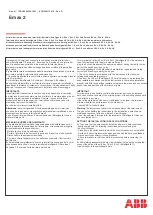
Before beginning
any fault clearances, disconnect the breaker from
the high voltage syst~m and earth it in accordance with the regula-
tions applicable.
.,--
Check the position of the closing spring
-
Measure the supply voltage
-
Disconnect the control circuits
-
Check the SF6 gas pressure
-
Check the termi na"1 connections
if tight and correct
-
Check the wiring against the diagrams. Correct, if necessary
-
Check
the
shunt
I'e
1
ease,
rep
1
ace defect ive coil s • Check the
reason and eliminate any mechanical jamming
-
Check,
if necessi1"ryreplace,
the contactors
in the defective
circuit
If the SF6 density monitor is defective, replace it
-
Switch on the supply voltage
In the event of an "~,F6 alarm" check the gas pressure and refill.
Check the dens ity mon
i
tor and, if necessary, replace it.
Should a gas leakage be assumed, check all flange connections
as
well as all pipe and soldered fittings with a leak detector, leak
detection spray or SO:lp suds.
Renew faulty soldered connections, thighten leaking connections. In -
case of leaking flanges, disassembly of the respective pole column
may be necessary.
.
Summary of Contents for SF6
Page 21: ...Fig 83 Exploded view of tle spring operating mechanism ...
Page 31: ...SF 1377 0 SF 1377 d SF 1377 0 SF 1377 0 SF 1377 _ 0 SF 1377 d SF 1377 0 SF 1377 0 ...
Page 32: ...SF 1377 c rUlUb m m I SF 1377 c J i SF 1377 SF 137 b 0 SF 1377 SF 1377 0 b ...
Page 33: ...BeruLub FK 33 Fig B8 Points of lubrication at the interrupter unit and at thE arcing contacts ...
Page 34: ...SF 1377 bl SF 1377 bl SF 1377 II 1 _ _ _ __ L i SF 1377 bl SF 1377 cl SF 1377 bl SF 1377 bl ...
Page 35: ...1 CLtl _ l1oLykote BR2 pLus l 0 ...
Page 38: ...2 7 17 2 7 18 2 7 16 2 7 02 2 7 18 2 7 03 2 7 01 2 7 06 2 7 11 2 7 07 2 7 22 ...











































